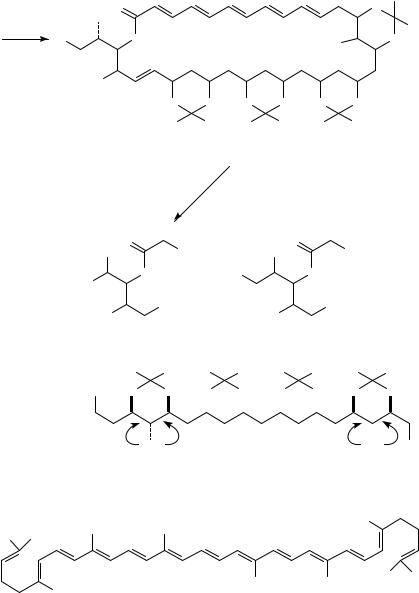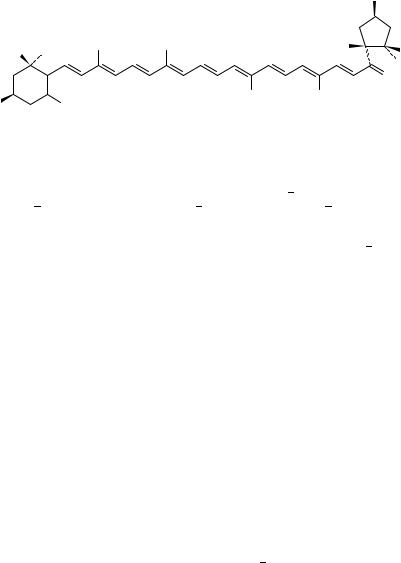

10. Analysis of dienes and polyenes and their structure determination |
501 |
Mystatin is a light-yellow optically active solid (d.p. > 160 °C) with UV |
max |
290, 307, 322 nm. Many of the polyene mycolides (e.g. Amphotericin B) are yellow solids with a similar conjugated transoid (5 to 7 double bonds) system, claimed to be derived, by structure similarity, from ˛-prinarate CH3CH2(CHDCH)4(CH2)7COOCH3. Some 200 members of this family were isolated and the structures of 40 of them were elucidated. Up to 1987 the only claim for full stereochemical elucidation by various techniques was for Amphotericin B47. Despite the fact that most of these compounds are solids, not all of them could be determined structurally by X-ray crystallographic methods and this includes the structures of Mycoticin A, B and derivatives47. Hence, other chemical and spectrocopical methods had to be employed. For spectroscopic measurements the free OH-groups were formylated, and the tetraformyl derivative exhibited well-resolved signals in the 1H NMR and 13C NMR spectra48. For this derivative use of the 2D COSY NMR and NOE techniques enabled a better assignment of non-equivalent hydrogens. The polyene part showed the all-trans stereochemistry. Ozonolysis of the tetraacetonide derivative (24) followed by NaBH4 reduction provided three, readily separable products
whereas the polyene conjugated system is totally oxidized to
VIII. ANALYSIS OF CAROTENOIDS AS AN EXAMPLE OF POLYENE STUDIES
This section is based on a review written in 1985 by Liaaen-Jensen and Andrewes49 and a book on Natural Products by Ikan50. Both reviews cover some 200 references and discuss the various isolation and identification methods at length. It is therefore redundant to repeat the information presented in them.
Nevertheless, during inspection of the above-mentioned reviews and many of the works cited therein, many excellent analytical methods which can be applied to other polyene molecules were found.
Since the recognition of the carotenoid family of pigments, approximately 500 600 naturally occurring members of the various families were recognized. The C40 skeleton of 8 isoprenoid units (tetraterpenoid) allows endless combinations with various positions carrying substituted groups such as alcohols, ketones, acids and others. The characteristic property which makes the carotenoids natural pigments is the long polyene conjugated systems. Carotenoids are found in almost all photosynthesizing biota from quite primitive bacteria to fruits and high plants. Because of their natural source many food manufacturers use carotenoids as food colors, hence the commercial interest.
Ikan’s book on laboratory techniques50 concentrates on the origin and isolation procedures of carotenoids. The spectra given (IR, UV-VIS and NMR, MS) help also to classify the various carotenoids. The longest open conjugated system (no rings) is found in lycopene, 28, which contains 11 conjugated and 2 non-conjugated double bonds, has an all-trans geometry and possesses a very intensive red colour ( EtOHmax 443, 472, 504 nm). This 536-dalton molecular weight (C40H56) polyene is analysed well by MS with most abundant fragments appearing at m/z 145, 119, 105, 93, 91, 86, 69 (base peak), 41 as shown below. The 1H NMR and 13C NMR assignments for the hydrogens and carbons double bond are as follows:
13C NMR (in CDCl3) in ppm
C-1 131.64; C-2 124.12; C-3 26.83; C-4 40.30; C-5 139.30; C-6 125.94; C-7 124.87; C-8 135.54; C-9 136.15; C-10 131.64; C-11 125.21; C-12 137.46; C-13 136.54; C-14 132.71; C-15 130.17; C-16 25.66; C-17 17.70; C-18 16.97; C-19 12.90; C-20 12.81.
1H NMR (in CDCl3) in ppm
H-2 υ5.11; H-3/H-4 2.11; H-6 5.95; H-7 6.49; H-8 6.25; H-10 6.19; H-11 6.64; H- 12 6.35; H-14 6.23; H-15 6.63.

502 |
|
Zeev Aizenshtat |
|
|
|
|
||
|
|
|
|
|
|
|
|
Me |
|
|
O |
|
|
|
|
|
O |
|
|
Me |
|
|
|
|
|
Me |
acetone |
|
|
|
|
|
|
|
|
R |
O |
|
|
|
|
|
O |
|
22 |
|
|
|
|
Me |
|||
p-TsOH |
|
|
|
|
|
|
|
|
|
|
|
|
|
|
|
|
|
70−75% |
|
|
|
|
|
|
|
|
|
|
Me |
|
|
|
|
|
|
|
|
O |
O |
O |
O |
O |
|
O |
|
|
Me |
Me |
Me |
Me |
Me |
|
Me |
(24)
1.O3 , −78 °C, MeOH/CHCl3 ;
|
|
|
NaBH4 , 0 °C |
|
|
2. A c2 O, Et3 N, |
|
|
|
|
|
|
||||
|
|
|
|
|
|
|
DMA P (cat.), 80%(5) |
|
|
|
|
|||||
|
|
|
|
|
|
|
DMA P = 4-dimethylaminopyridine |
|
|
|||||||
|
|
O |
|
|
|
|
|
|
|
|
O |
|
|
|
|
|
|
|
Me |
|
OA c |
|
|
|
|
Me |
|
|
OA c |
|
|
|
|
|
|
|
O |
|
+ |
Me |
|
|
O |
|
|
|
|
|||
|
|
Me |
|
|
|
|
|
|
|
|
|
|
|
|
||
|
|
|
|
OA c |
|
|
|
|
|
|
|
|
OA c |
|
|
|
|
|
Me |
|
|
|
|
|
|
Me |
|
|
|
|
|
|
|
|
|
(25) |
|
|
|
|
|
|
|
(26) |
|
|
|
|
|
|
|
|
Me |
|
Me Me |
Me |
Me |
Me |
Me |
|
Me |
|
|||||
|
|
OAc O |
|
O |
O |
O |
O |
O |
O |
|
O |
|
||||
|
+ |
13 |
14 |
15 |
|
|
|
|
|
|
|
|
25 |
26 |
27 |
|
|
|
|
|
|
|
|
|
|
|
|||||||
|
|
|
|
|
|
|
|
|
|
|
|
|
|
|
||
|
|
|
Me |
|
|
|
|
|
|
|
|
|
syn |
|
OAc |
|
|
|
(or enant.) |
|
|
|
|
|
|
|
|
|
|
|
|||
|
|
|
|
|
|
(27) |
|
|
|
(or enant.) |
|
|||||
|
|
|
|
|
|
|
|
|
|
|
|
|
||||
|
|
|
|
|
|
|
|
|
|
|
|
|
|
|
|
|
|
|
|
|
SCHEME 5 |
|
|
|
|
|
|
|
|
||||
|
|
CH3 |
|
CH3 |
|
|
|
|
|
|
|
|
H3 C |
|
|
|
H3 C |
CH3 |
|
|
|
|
|
|
|
|
|
|
|
|
|
||
|
|
|
|
|
|
|
|
|
|
|
|
|
|
|
||
|
|
|
|
|
|
|
|
CH3 |
|
CH3 |
H3 C |
CH3 |
||||
|
CH3 |
|
|
|
|
|
|
|
|
|
|
|||||
|
|
|
|
|
|
|
|
|
|
|
|
|
|
|
|
|
|
|
|
|
|
(28) |
|
|
|
|
|
|
|
|
|
||
Mass spectrum
m/z 536 (21.7%, M), 145 (38%), 119 (34%), 105 (47%), 93 (36%), 91 (47%), 81 (36%), 69 (100%), 41 (57%).
EtOHmax 443, 472, (ε D 3.105) 504 nm.

10. Analysis of dienes and polyenes and their structure determination |
503 |
For comparison the 1H and 13C NMR spectra, the mass spectral fragments and the UV-VIS spectrum of Capsantin, 29 (the red colour of paprika), are as follows:
|
|
|
|
|
|
|
OH |
|
|
|
|
19 |
20 |
|
18′ |
4′3′2′ |
|
17 |
16 |
|
|
5′ |
1′ 16′ |
|||
|
CH3 |
CH3 |
|
CH3 |
||||
CH3 |
CH3 |
14′ |
|
CH3 |
||||
|
|
10′ |
6′ |
|||||
|
|
|
|
|
CH3 |
|||
2 |
1 6 |
7 |
9 10 |
11 12 13 14 15 15′ |
13′ 12′ 11′ |
9′ 8′ |
7′ |
O 17′ |
3 |
4 5 |
18 |
|
|
CH3 |
CH3 |
|
|
HO |
|
CH3 |
|
|
20′ |
19′ |
|
|
|
|
|
|
(29) |
|
|
|
|
1H NMR (in CDCl3) in ppm
0.840[s,3H, Me (160 )], 1.075[s, 6H, Me(16), Me(17)], 1.207[s, 3H, Me(170 )], 1.367[s, 3H, Me(180 )], 1.736[s, 3H, Me(18)], 1.957[s, 3H, Me(190 )], 1.974[s, 6H, Me(19), Me(20)], 1.989[s, 3H, Me(200 )], 2.39[ddd, J D 17.6, ca 1.5, 1H, H˛ C(4)], 2.96[dd, J D 15.5, 9, 1H, H˛ C(40 )], ca 4.00[br, m, 1H, H˛ C (3)], 4.52[m, 1H, H˛ C(30 )], 6.13[s, 2H, H-C(7), H-C(8)], 6.16[d, J D 11.6, 1H, H-C(10)], 6.26[d, J D 11; 1H, H-C(14)], 6.35[d, J D 11, ca 1H, H-C(140 )], 6.36[d, J D 15, 1H, H-C(12)], 6.45[d, J D 15, 1H, H- C(70 )], 6.52[d, J D 15, 1H, H-C(120 )], 6.55[d, J D 11, 1H, H-C(100 )], ca 6.6 6.8[m, 4H, H-C(11), H-C(110 ), H-C(15); H-C(150 )], 7.33[d, J D 15, 1H, H-C(80 )].
13C NMR (in CDCl3) in ppm
12.75[C(19)], 12.79[C(20)], 12.84[C(190 )], 12.90[C(200 )], 21.39[C(180 )], 21.63[C(18)], 25.16[C(170 )], 25.95[C(160 )], 28.80[C(16)], 30.32[C(17)], 42.69[C(4)], 44.01[C(10 )], 45.49[C(40 )], 48.61[C(2)], 51.06[C(20 )], 59.01[C(50 )], 65.41[C(3)], 70.44[C(30 )], 121.04[C (70 )], 124.13[C(110 )], 125.58[C(11)], 125.93[C(7)], 126.30[C(5)], 129.74[C(150 )]; 131.27[C(10)], 131.68[C(150 )], 132.39[C(14)], 133.69[C(90 )]; 135.24[C(140 )]; 135.93[C (130 )], 137.46[C(12)], 137.60[C(13)], 137.85[C(6)], 138.51[C(8)], 140.63[C(100 )], 141.97[C(120 )], 146.86[C(80 )], 202.82[C(60 )].
Mass spectrum
m/z 584 (75%, M), 478 (62%), 429 (6%), 145 (51%), 127 (36%), 109 (100%), 106 (31%), 105 (44%), 91 (65%), 83 (56%).
benzenemax 486 (ε D 1.2 ð 105), 520 nm.
All polyenes are susceptible to changes under various chemical conditions: oxygen, peroxides, light, acids and elevated temperature, etc. Therefore, one should bear in mind that carotenoid separation must be very carefully planned. Various extractions and liquid chromatographies are offered51 with special separation by partition between immiscible solvent systems. Another problem caused during separation is a geometrical isomerization usually in the cis ! trans direction. During the 1950s column chromatography was exclusively used, whereas since then TLC and PTLC (Preparative Thin Layer Chromatography) are employed51. HPLC (High Performance LC), both reversed phase and on regular silica (>5 ), are used with various UV-VIS detectors (see Section III).
The carotenoids exhibit very high ε values of 105 3 ð 105 and hence very small quantities can be detected. Due to the high molecular weights of carotenoids and other polyenes GC can be employed only with the perhydrogenated compounds15 due to the high temperatures needed52.
Although 1H NMR and 13C NMR spectroscopy of dienes and polyenes is discussed elsewhere, these tools of analysis are very nicely demonstrated in the studies of carotenoids.

504 |
Zeev Aizenshtat |
The advancement of >400 MHz NMR instruments with spin decoupling and Fourier transform software now allows identification of individual olefinic protons of nanogram carotenoids53. We have shown two examples (lycopene and capsantin) for which the chemical shifts have been employed in the assignment of relative configuration49. As for review of the 13C NMR of carotenoids, Englert in 198154 gave information especially on the position of the cis double bonds in a polyene chain.
The fragmented ions are stabilized in aromatic structures and therefore their formation may be misleading. However, some carotenoids do have aromatic moieties (e.g. flexirulein and some of the xanthomonadins). Therefore, if we examine the MS of capsanthin (see above) we see the base peak at m/z 109 (C7H9O or C8H13) next in abundance to the molecular peak (75%) at m/z 584 and the tropylium ion C7H7C (65%) at m/z 91. It is interesting that although lycopene has no ring structures it exhibits an m/z 91 fragment as a very strong peak. It is therefore very helpful to check for the presence of other functional groups such as OH, CO, etc. by IR spectroscopy.
The carotenoid family have chiral centres which enable the use of circular dichroism. However, the chirality of carotenoids is not sufficiently characteristic so that the chiroptical properties do not serve as a good analytical tool.
Various chemical derivatizations of natural carotenoids may serve to improve separation and lead to better characterization of structure. These methods are discussed in Section VI.
IX. ACKNOWLEDGEMENTS
The author wishes to thank the BSF (USA Israel) and the Research and Development Department of the Ministry of Energy and Infrastructure (Israel) for financial support of the group during the period in which this review was written, and also Ms. Dorit Aschengru for technical support.
X. REFERENCES
1. B. S. Hudson, B. E. Kohler and K. Schulten, Excited States, 6, 1 (1982); B. S. Hudson and
B. E. Kohler, Annu. Rev. Phys. Chem., 24, 437 (1974).
2.G. Orlandi, F. Zebetto and M. Z. Zgierski, Chem. Rev., 91, 867 (1991).
3.J. G. Aston, Ph.D. Thesis, Univ. of California, Berkeley (1946).
4.L. H. Carreia, J. Chem. Phys., 62, 3851 (1975).
5.(a) R. B. Woodward, J. Am. Chem. Soc., 64, 72 (1942).
(b) L. F. Fieser and M. Fieser, Steroids, Reinhold, New York, 1959, pp. 15 21.
6.S. T. Belt, D. A. Cooke, S. J. Hird and S. Rowland, J. Chem. Soc., Chem. Commun., 2077 (1994).
7.H. Budzikiewicz, C. Djerassi and D. H. Williams, Interpretation of Mass Spectra of Organic Compounds, Holden-Day, San Francisco, 1964.
8.S. E. Van Bramer and M. V. Johnson, Org. Mass Spectom., 27, 949 (1992).
9.B. A. Dimitrova, C.R. Acad. Bulg. Sci., 32, 1381 (1979).
10.S. J. Hird, R. Evens and S. J. Rowland, Marine Chemistry, 37, 117 (1992).
11.N. R. Avery and N. Sheppard, Proc. R. Soc. London. Ser. A, 405, 27 (1986).
12.N. R. Avery and N. Sheppard, Proc. R. Soc. London. Ser. A, 405, 1 (1986).
13.R. I. Reed, Application of Mass Spectrometry to Organic Chemistry, Academic Press, New York, 1966.
14. J. Oro´ and D. Nooner, ‘Cosmochemical and Geochemical Application of Mass Spectrometry’, in Practical Mass Spectrometry (Ed. B. S. Middleditch), 2nd edn., Plenum Press, New York and London, 1981, pp. 327 359.
15.Z. Aizenshtat, in The Chemistry of Alkanes and Cycloalkanes (Eds. S. Patai and Z. Rappoport), Chap. 7, Wiley, Chichester, 1992, pp. 289 349.
16.J. P. Jasper and J. M. Hayes, Nature, 347, 462 (1990).
17.M. Lyle, Nature, 356, 385 (1992).
18.G. Eglinton, S. A. Bradshaw, A. Rosell, M. Sarnthein, U. Pflaumann and R. Tiedemann, Nature, 356, 423 (1992).

10. Analysis of dienes and polyenes and their structure determination |
505 |
19.W. Vetter, G. Englert, N. Rigassi and U. Schwieter, in Carotenoids (Ed. O. Isler), Birkhauser,¨ Basel, 1971, pp. 189 266.
20.C. R. Enzell and I. Wahlberg, in Biochemical Application of Mass Spectrometry (Eds. G. R. Waller and O. C. Dermer), Wiley, New York, 1980, pp. 407 436.
21.H. Budzikiewicz, in Carotenoid Chemistry and Biochemistry (Eds. G. Britton and T. W. Goodwin), Pergamon, Oxford, 1982, pp. 155 166.
22.H. Achenbach, W. Kohl, A. Bottger¨-Vetter and H. Reichenbach, Tetrahedron, 37, 559 (1981).
23.A. G. Andrews, S. Hertzberg, S. Liaaen-Jensen and M. P. Starr, Acta Chem. Scand., 27, 2383 (1973).
24.C. D. Watts, J. R. Maxwell, D. E. Games and M. Rossiter, Org. Mass Spectrom., 10, 1102 (1975).
25.H. Budzikiewicz, S. Blech and B. Schneider, Org. Mass Spectrom., 26, 1057 (1991).
26.D. F. Hunt and T. M. Harvey, Anal. Chem., 47, 2136 (1975).
27.J. Adams, Mass Spectrom. Rev., 9, 141 (1990).
28.R. Neumann and A. M. Khenkin, Chapter 20 in this volume.
29.K. A. Jorgensen and B. Schiott, Chem. Rev., 90, 1483 (1990).
30.V. N. Odinokov and G. A. Tolstikov, Russ. Chem. Rev., 50, 1207 (1981).
31.G. P. McSweeny, J. Polym. Sci., A-1, 6, 2 (1968).
32.D. Swern, Organic Peroxides, Vol 2, Wiley Interscience, New York, 1971.
33.I. E. Pokrovskaya, A. T. Menyailo and A. K. Yakovleva, in Progress in the Chemistry of Organic Peroxy Compounds and Autooxidation (Ed. N. M. Emanuel), Khimia, Moscow, 1969, p. 124.
34.V. N. Odinokov, R. S. Bakeeva and G. A. Tolstikov, Izv. Akad. Nauk SSSR., Ser. Khim., 2836 (1978).
35.J. Itakura, H. Tanaka and H. Ito, Bull. Chem. Soc. Jpn., 42, 1604 (1969).
36. R. Clarke, M. Gahagan, R. K. Mackie, D. F. Foster, D. J. Cole-Hamilton, M. Nicol and
A. W. Montford, J. Chem. Soc., Dalton Trans., 1221 (1995).
37.D. Mustafi, W. E. Boisvert and M. W. Makimen, J. Am. Chem. Soc., 115, 3674 (1993).
38.G. Wald, Science, 162, 230 (1968).
39.G. K. Estok and J. S. Dehn, J. Am. Chem. Soc., 77, 4769 (1955) and references cited therein.
40.E. A. Cherniak and C. C. Costain, J. Chem. Phys., 45, 104 (1966).
41.R. Rowan III, J. A. McCammon and B. D. Sykes, J. Am. Chem. Soc., 96, 4773 (1974) and references cited therein.
42.S. K. Malhorta and H. J. Ringold, J. Am. Chem. Soc., 86, 1997 (1964).
43.P. Devaux and E. C. Horning, Anal. Lett., 2, 637 (1969).
44.L. Dehennin and R. Scholler, Tetrahedron, 29, 1591 (1973).
45.E. L. Hazen and R. Brown, Science, 112, 423 (1950).
46.C. N. Chong and R. W. Rickards, Tetrahedron Lett., 5145 (1970); E. Borowski, Tetrahedron Lett., 685 (1971).
47.S. L. Schreiber and M. T. Goulet, Tetrahedron Lett., 28, 6001 (1987) and references cited therein.
48.S. L. Schreiber and M. T. Goulet, Tetrahedron Lett., 28, 6005 (1987) and references cited therein.
49.S. Liaaen-Jensen and A. G. Andrewes, in Methods in Microbiology, Vol. 18, Chap. 8, Academic Press, New York, 1985, pp. 235 255.
50.R. Ikan, Natural Products, a Laboratory Guide, 2nd edn., Academic Press, New York, 1991.
51.B. H. Davis, in Chemistry and Biochemistry of Plant Pigment (Ed. T. W. Goodwin), Vol 2, Academic Press, New York, 1976, pp. 38 155.
52.R. F. Taylor and M. Ikawa, in Methods in Enzymology (Eds D. B. McCormick and L. M. Wright), Vol. 67, Academic Press, New York, 1980, pp. 233 261.
53.A. Fiksdahl, T. Bjørnland and S. Liaaen-Jensen, Phytochemistry, 23, 649 (1984).
54.G. Englert, in Carotenoid Chemistry and Biochemistry (Eds. G. Britton and T. W. Goodwin), Pergamon Press, Oxford, 1981, pp. 107 134.
